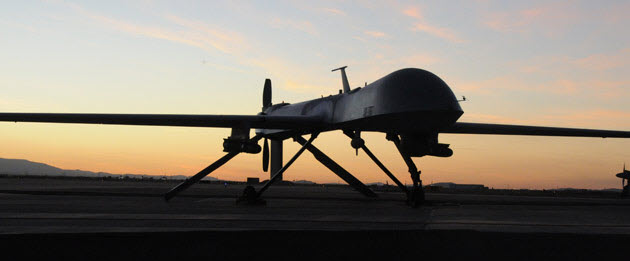The Drone Controversy, Viewed From All Sides
Senate scrutiny of John Brennan to head CIA brings issue to forefront Feb 16 2013As the confirmation hearings by the Senate of John Brennan to be named CIA director drew near, the heat intensified over the program of death by drone enough to cause the Obama White House to finally relent, pledging to release to lawmakers the document that it had even gone to court to keep secret.

An opinion from the Office of Legal Counsel, the document gives the President legal cover for killing, without due process of trial, an American citizen in September of 2011 in Yemen and of his 17-year-old son two weeks later. The practice of conjuring after-the-fact legal justifications for deeds already done brings to mind the opinions issued by that same office during the Bush administration that blessed “enhanced interrogation techniques”, otherwise known as torture.
Just days before the hearing, NBC News had obtained and released a copy of a white paper that supposedly summarized the contents of the longer opinion. That finally undercut the White House’s long campaign to keep secret its arguments why a program of targeted killing is constitutionally defensible, but, even with the white paper out in the open, the full opinion is still classified and may be read only by intelligence committee members. That should make clear that the rights claimed for the President are far more incendiary than in the summary.
The white paper sets three requirements for what it deems lawful “lethal force in a foreign country” against “a senior operational leader of al-Qa’ida [government spelling] or an associated force”. That license to kill specifically includes “an operation against a U.S. citizen”. The target must (1) “pose an imminent threat of violent attack against the United States, (2) capture is infeasible…and (3) the operation would be conducted in a manner consistent with applicable law of war principles”.
The program immediately runs aground with the word “imminent” — is the government hoping we will believe there were hundreds of plots afoot when it eliminated the hundreds so far killed? — so the memo is at pains to expand imminent’s meaning beyond recognition. In a speech last March, Attorney General Eric Holder said imminence does not require knowledge of a specific attack on U.S. persons or interests. If the U.S. believes that the target has in the past been involved in violent activities and has not renounced such activities, that has come to mean "imminent" and justifies an attack.
Similarly, as apparently capture is almost never attempted, the question of what are the criteria that determine infeasibility arises? This is a reversal of the Bush-era practice, where drones — not then so fully developed — were used less and capture used more. But now, avoiding risk to American personnel seems universally to decide the matter.
Those who press for capture — or who ask why don’t we first offer surrender — seem clueless about the harrowing prospect of dropping special operations troops into remote and forbidding patches of Pakistan or Yemen and then extracting them safely after a mission, and then there's the time lapse between spotting a target by drone and getting troops to the scene, armed and fully equipped with a plan of action.
the decider The third criterion, following the “law of war”, brings up a myriad of questions, the first being whether the U.S. has invented its own. In a June 2011 report to Congress, the Obama administration mined semantic loopholes to skirt the War Powers Resolution of 1973, saying that congressional approval is not required because drone attacks do not involve “sustained fighting”, “active exchanges of fire” or a “serious threat” of American casualties. The White House further argues that Congress’ 2001 Authorization for Use of Military Force (AUMF) and a nation’s right to protect itself under international law is justification enough to target individuals for assassination who are affiliated with Al Qaeda or “associated forces”.
But are there no limits and no rules, others ask? Isn’t this an argument that self-defense permits the President to decide to overfly any country and put its people to death — and based on secret information that the military and the CIA do not allow even congressional oversight committees to see? What is the military’s Joint Special Operations Command (JSoc) allowed to do in the 70 countries in which it now operates.
What about in the U.S.? There are reports that drones from the local anti-terrorism center in California have been brought into the search for former police officer and Naval lieutenant Christopher Dorner. He certainly meets the test for "terrorist" but will we assassinate without attempt to capture for trial?
Is the drone war the proper business of the CIA? Shouldn’t they limit their activities to the collection of intelligence. When did they become permanently licensed to kill?
Brennan insistentAs for Anwar al-Awlaki, the American citizen and Yemen imam who urged jihad against the U.S., Brennan was insistent in his confirmation hearing that his killing was warranted. Brennan said al-Awlaki had been linked to three attacks intended or carried out in the U.S.: an attempt to bring down an airliner bound for Detroit, another targeting cargo planes in 2010, and notably the Ft. Hood shooting in which 13 died. "He was intimately involved in activities to kill innocent men, women and children, mostly Americans," Brennan said.
Americans are generally untroubled by the elimination of al-Awlaki. The debate centers on whether the President or the government has the right to to take an American citizen’s life, in secret, with no oversight, without public presentation of evidence, without due process of trial.
collateral civiliansThe rising public concern is how many civilians the drone war is killing. The law of war requires the assumption that one is a civilian unless proved otherwise, but the drone program has made that notion rather quaint.
In June 2011, Brennan made the bizarre claim that there had been zero civilian deaths the year before “because of the exceptional proficiency, precision of the capabilities we’ve been able to develop”. To the contrary, the U.K.-based Bureau of Investigative Journalism has been tallying drone strikes since 2004 — to the degree it is able, given secrecy — and reports 2,600 to 3,400 killed in Pakistan to date, 473 to 893 of them civilians and 176 children. The New America Foundation estimates between 261 and 305 civilians have been killed in Pakistan. Deaths in Yemen are less — 370 to 1,100 killed, 70 to 180 civilians — but the number of strikes is on the rise. The administration claims the numbers are much lower.
It became apparent that Brennan’s zero count owed to the administration considering all military age males in a strike zone as assumed combatants, not civilians. This is not as far-fetched as it seems. An administration official gave ProPublica this example: “If a group of fighting age males are in a home where we know they are constructing explosives or plotting an attack, it's assumed that all of them are in on that effort.”
The ratio of civilian deaths has dropped, according to the public watchdog groups who try to keep score (the Long War Journal covers Pakistan and Yemen; the New America Foundation covers Pakistan; the London Bureau of Investigative Journalism covers Yemen, Somalia, and Pakistan and Afghanistan).
justifiable homicideThe argument that drone warfare is justifiable is bolstered by having to deal with an enemy that is not state-sponsored, wears no uniform, lives among and blends into their populations, effectively using them as human shields. That makes civilian deaths unavoidable. If that is the form of warfare they choose, so is the United States free to choose its own asymmetric method against a foe that actively plots to kill Americans.
The American public agrees. Killing the enemy with unmanned aircraft saves the lives of American pilots and soldiers. Over eight in ten approve of drones in a February 2012 Washington Post-ABC poll. Two-thirds even approved of targeting Americans who are suspected of being terrorists. Merely “suspected”, note.
But if the U.S. claims to do the utmost to spare the innocent, how can a convincing argument be made that “signature strikes” aren’t killing civilians? This practice began under Bush and has been used more extensively under Obama. It targets for killing unidentified individuals or groups who simply show a “signature of behavior” that is congruent with terrorist or militant group behavior. Make the mistake of looking suspicious and with no further proof, a drone will incinerate you. The CIA is scornful of an administration that thinks “three guys doing jumping jacks” must be a terrorist training camp.
How is it known that militants targeted by the U.S. are actually hatching plots against this country? There is concern that we are making the same mistake as we did by sweeping up people for internment in Guantánamo, a large percentage of whom were innocents, or family vendetta foes, fingered by Afghans seeking bounty payments offered by the U.S. There are other accusations that the U.S. may to some degree be operating “a counterinsurgency air force”, eliminating militants as a favor to the governments of allied countries.
recruiting for the enemyIn Pakistan and Yemen, drones deeply anger those on the ground. Their constant presence above, the anxiety and paranoia induced by not knowing when they might be shredded by a strike, has inculcated a universal hatred of America. A report from Stanford and NYU documented “anxiety and psychological trauma” among Pakistani villagers.
Yet Brennan said last August that there is “little evidence that these actions are generating widespread anti-American sentiment or recruits”. But neither is there evidence that the U.S., circling endlessly in the sky in drones piloted from bunkers as far away as New Mexico, goes looking for such evidence. Brennan said in a speech last year, “Yemeni citizens who have been freed from the hellish grip of AQAP [al-Qaeda in the Arabian Peninsula] are more eager, not less, to work with the Yemeni government”. But he is hearing this from his contacts in the Yemeni government, eager for U.S. help, not from villagers themselves.
General Stanley McChrystal, the former commander of the military in Afghanistan, disagrees, saying, “The resentment created by American use of unmanned strikes ... is much greater than the average American appreciates. They are hated on a visceral level, even by people who've never seen one or seen the effects of one.” He and others, such as Michael Hayden, the former C.I.A. director, are troubled that in Pakistan and Yemen we are expanding our attacks unnecessarily, killing junior-grade militants who are well removed from being a direct threat to the United States and thereby fueling hatred all the more. As the New York Times reminds us,
“even members of Al Qaeda invariably belong to a tribe, and when they are killed in drone strikes, their relatives — whatever their feelings about Al Qaeda — often swear to exact revenge on America”.
Medea Benjamin, a firebrand often dragged from hearings such as the Senate’s review of Brennan, puts it this way: “Three out of four Pakistanis now see the U.S. as their enemy — that’s about 133 million people, which certainly can’t be good for U.S. security”.
Al Qaeda has spread from Afghanistan and Pakistan to Yemen, Somalia, and now Libya and Mali. Does the drone program recruit more terrorists than it kills? Are we simply growing an endless war?
Please subscribe if you haven't, or post a comment below about this article, or
click here to go to our front page.


WE should bring our soldiers home. It is a waste of our soldiers and money!. We will not be able to stop the spread of Islamic takeover of Africa. It is a total waste of money.